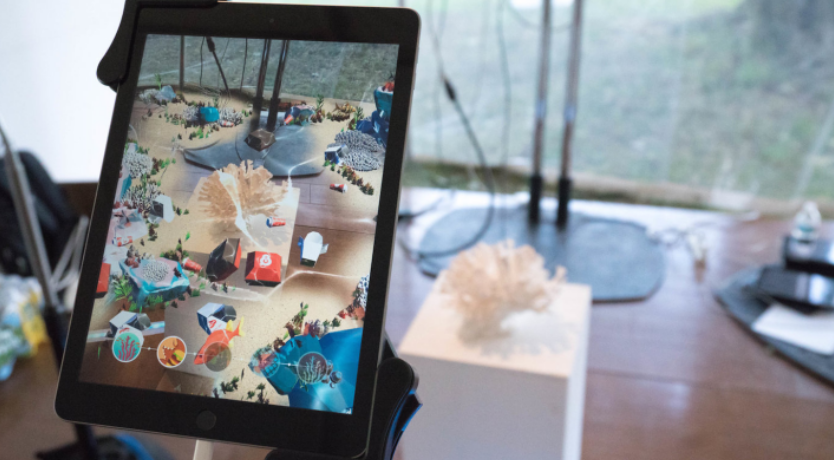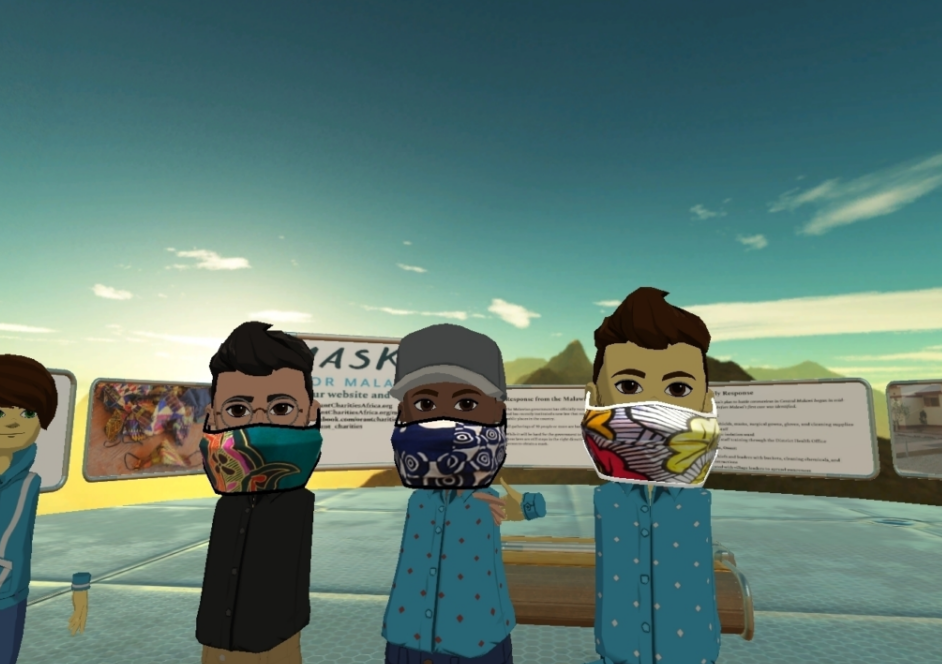Written by Blake Aber
Fundraising is a vital part of a nonprofit’s ability to achieve its mission. Cultivating relationships with individuals and institutions in this way can help an organization gain economic support, as well as important relationships and visibility. In order to create and maintain these relationships in development departments, organizations need to meet potential partners where they are and inspire them through their mission and projects. Today, and in the near future, these potential donors may likely be in a virtual space, specifically augmented reality (AR) and virtual reality (VR). According to the Intenational Data Corporation AR and VR hardware ownership increased 92.1% in 2021 from the previous year by both individuals and organizations. It projects that by 2026 approximately 30.8 million individuals will own AR and VR hardware.
It seems that many nonprofits do understand the increasing abundance of virtual space. According to BDO, “There is a large push to increase the adoption of technology by organizations, with 64 percent of nonprofits planning to invest in new tech this year.” Entering the virtual space though AR and VR technology can afford nonprofit organizations new opportunities in fundraising.
What is AR & VR?
Before understanding this technology’s importance in fundraising, it is crucial to know what AR and VR are and why individuals and companies are using them.
AR technology allows physical spaces to be transformed with a layer of “digital augmentation.” This technology works by modifying a digital space and making that respective space new or more interactive than it was previously. In many cases AR is used to gamify the physical space. AR software can be utilized on most smartphones and tablets, as well as headsets and kiosks. Due to the fact that it is available to individuals who own a smartphone, AR is fairly accessible. Continually, AR technology is a smart tool for organizations or companies to use because AR indices audiences to interact longer with marketing media than they would before.
VR technology is software that allows users to enter into a completely virtual and artificial space. Most commonly, VR software is accessed through headsets, like the Meta Quest 2. The headset and VR technology give the user a completely immersive, three-dimensional experience. When utilizing a VR headset, the user is taken out of the physical world and placed into a new virtual space.
Due to this ability, VR has become increasingly popular in the professional world. In recent years VR has been used to train employees in both hard and soft skills and has become a preferred training method to in-person training in many cases. According to a study done by Price Waterhouse Coopers, “Virtual learners were 3.75 times more emotionally connected to content than classroom learners.” Data that proves VR’s ability to engage its users is an advantage to companies and organizations who want to train new employees, give presentations to colleges, and bring on new investors or donors.
AR & VR Tangibly Presents Mission-Related Problems
AR and VR popularity has already grown rapidly in the past few years, and will seemingly become more common. Therefore, nonprofit organizations can benefit from utilizing this immersive and engaging technology to interact with potential donors.
A primary advantage of AR and VR is that nonprofit organizations can utilize this technology to create connections based on compassion between a nonprofit’s mission and potential donors through engaging experiences. Additionally, nonprofits can leverage AR and VR to allow potential donors to experience the problem a nonprofit organization is trying to solve. Of this, AR Insider states, “Rather than just telling prospective donors about your cause, you can show them in either a virtual world (VR), or in the real world with virtual aspects overlaying (AR).” The organization Alzheimer’s Research UK communicated to potential donors the hardships individuals with Dementia face each day with the VR experience “A Walk Through Dementia”. The VR experience guides users through a grocery store, a home environment, and driving a car. Each stage of the experience presents common Dementia symptoms that hinder Dementia patients’ functioning in these scenarios. This project created by Alzheimer’s Research UK empowered individuals to understand Dementia in a way they were not able to before. Because of this, potential donors are able to better understand the issue that their support is going towards.
An art installation in 2017 used AR to encourage individuals to support and protect our oceans. White Noise used data to show audiences the amount of trash that ends up in the ocean. The installation features AR technology that enhances a white, 3D printed piece of coral. The AR was updated using Twitter to show audiences the impact they were having on the ocean. Swimming fish and bright coral are shown alongside trash. This project presents another example where this technology shows potential donors an issue that would have been hard to visualize through pictures and reports alone.
Figure 1: White Noise AR installation at the Future of Storytelling at Snug Harbor, Staten Island. Source: Paper Triangles.
VR Fundraising Events Create Global Recognition
Nonprofits can also use VR technology to hold fundraising events in a virtual space. In 2020, the organization Orant Charities Africa created a VR fundraising event for their “Masks for Malawi” campaign. It held in the app AltSpaceVR, which is a social platform where organizations can host “[…] live, virtual events.” This virtual fundraiser was considered to be the first of its kind. Orant Charites Africa noted that guests attended from different countries all over the world. This VR event, and the ones the organization plans to hold in the future, allow the nonprofit to interact with potential donors from across the globe at the same event.
Figure 2: A look inside the global Orant Charites Africa VR fundraising event. Source: Orant Charities Africa.
VR fundraisers give nonprofit organizations the opportunity to display their mission on a global stage to constituents who are located anywhere. As stated in an article published by MuseumNext, “Virtual content, online events and social media presence can make your fundraising efforts less location-based and vastly increase the amount of potential fundraisers across the world.” This inclusive aspect of VR space is an advantage to organizations who are trying to reach donors that are not situated in a close geographical location. Potential donors no longer need to travel to have an interactive experience with a nonprofit organization. Instead, these donors can attend events from wherever they are and still have an immersive and engaging experience. For nonprofits who are situated in smaller areas that may be less conducive to travel, VR events can be a creative solution for increased reach.
Cost-Effective Innovation for Nonprofits
AR and VR technology can also be a practical investment for nonprofits to support their fundraising initiatives. In addition to this technology’s engagement advantages, AR and VR can have the ability to save organizations money in the long-term. According to BDO, “The use of technologies, including management platforms, data analytics software, automation, artificial intelligence, Internet of Things, virtual reality and others can save an organization money and resources in the long run.” For some nonprofits, it may be beneficial to look into their current operations and reevaluate what can be done in a virtual space. Many investments associated with this technology, such as hardware, only need to be purchased once, which can be cost effective. Therefore, if a nonprofit needs to create prototypes to show their potential donors new projects, it may be more affordable to do this virtually through AR or VR.
Virtual Fundraising Leads to Results
While investing in AR and VR technology is a large up-front cost, cases have proven that it is successful in achieving fundraising results. The nonprofit Pencils of Promise, which seeks to make education more accessible, utilized VR to hold a fundraising event in 2015. The organization created a VR experience that could show potential donors schools before and after the work of Pencils of Promise. By fabricating this immersive experience, potential donors were able to see what their monetary support would be used for in a visual and concrete way. The event was a success both monetarily and for the continued use of VR technology for fundraising. Of the funds raised from the initiative, “The evening’s VR installation and experience has not only helped position Pencils of Promise as an early adopter of social good storytelling […] but has also likely added to the gala’s success of raising over $1.9M from supporters during the night.” The case from Pencils of Promise demonstrates that this technology can be used to leverage a large amount of funding for nonprofits.
Figure 3: Potential donors participating in the Pencils for Promise 2015 fundraising event. Source: VRScout.
AR & VR Fundraising is Here to Stay
The advantages of fundraising using AR and VR have the potential to transform the fundraising space. While this technology is a large investment for organizations, the benefits may outweigh the costs for many nonprofits, especially as AR and VR technology will continue to become more accessible in the near future. Smartphones, which can support AR, are owned by 78.05% of the world’s population, and sales of both AR and VR hardware are continuing to grow each year .AR and VR give organizations the ability to animate both problems they seek to solve and the projects they will implement to solve them. This technology helps place nonprofits on a global stage, reaching audiences that they may have been unable to reach before. These advantages can be used to gain significant funds for organizations and help them to better achieve their mission-driven work.
+ Resources
“AR Hardware / Devices.” Augmented & Virtual Reality Agency, App and 3D Developer, 2 Feb. 2018, https://www.augmented-minds.com/en/augmented-reality/ar-hardware-devices/.
“AR & VR Headsets Market Share.” IDC, https://www.idc.com/promo/arvr.
“A Walk through Dementia.” A Walk Through Dementia, http://awalkthroughdementia.org/.
“Capture More Attention with Augmented Reality Social Posts .” Starmark, 2 Mar. 2022, https://www.starmark.com/blog/etips/capture-attention-with-augmented-reality/.
“First Use of Virtual Reality Fundraising a Hit with Members of the Public.” Amnesty International UK, https://www.amnesty.org.uk/press-releases/first-use-virtual-reality-fundraising-hit-members-public.
Guest, AR Insider. “How Can AR & VR Empower Fundraising?” AR Insider, 31 Dec. 2021, https://arinsider.co/2021/12/24/how-can-ar-vr-empower-fundraising/.
Joe Bardi. “Virtual Reality Defined & Use Cases: 3D Cloud by Marxent.” Marxent, 28 Apr. 2022, https://www.marxentlabs.com/what-is-virtual-reality/#:~:text=%5BDefinition%20and%20Examples%5D%201%20Virtual%20Reality%20%28VR%29%20is,HTC%20Vive%2C%20Oculus%20Rift%20and%20PlayStation%20VR%20%28PSVR%29.
Joy, Kevin. “How Nonprofits Use VR to Bring Their Causes to Life.” Technology Solutions That Drive Business, 4 May 2021, https://biztechmagazine.com/article/2018/04/how-nonprofits-use-vr-bring-their-causes-life.
Mansfield, Heather. “How Organizations Can Use VR and AR Tech for Fundraising.” Nonprofit Tech for Good, Nonprofit Tech for Good, 26 Mar. 2020, https://www.nptechforgood.com/2019/09/04/how-organizations-can-use-vr-and-ar-tech-for-fundraising/.
Meier, Allison. “An Augmented Reality Coral Reef Thrives or Dies by Your Tweets.” Hyperallergic, 3 Aug. 2021, https://hyperallergic.com/407677/white-noise-augmented-reality/.
Miller, April. “The Future of Nonprofits Lies in VR.” AR Insider, 17 Feb. 2022, https://arinsider.co/2022/02/17/the-future-of-nonprofits-lies-in-vr/.
Nafarrete, Jonathan. “How Pencils of Promise Raised $1.9m with the Help of VR.” VRScout, 21 Sept. 2016, https://vrscout.com/news/pencils-of-promise-virtual-reality/.
PricewaterhouseCoopers. “How Virtual Reality Is Redefining Soft Skills Training.” PwC, https://www.pwc.com/us/en/tech-effect/emerging-tech/virtual-reality-study.htm
“Quest 2: Our Most Advanced New All-in-One VR Headset: Meta Quest.” Social Metaverse Company, https://store.facebook.com/quest/products/quest-2/?utm_source=https%3A%2F%2Fwww.bing.com%2F&utm_medium=organicsearch.
“The Reality of a VR Fundraiser.” Orant Charities Africa, 27 Jan. 2022, https://orantcharitiesafrica.org/the-reality-of-a-vr-fundraiser/.
“Top 10 Trends in the Nonprofit Industry.” BDO, https://www.bdo.com/blogs/nonprofit-standard/july-2019/top-10-trends-in-the-nonprofit-industry.
“Topic: Smartphones.” Statista, https://www.statista.com/topics/840/smartphones/#dossierContents__outerWrapper.
Turner, Devon. “Fundraising with Membership Schemes.” MuseumNext, 9 Feb. 2022, https://www.museumnext.com/article/vips-only-fundraising-with-membership-schemes/.
Turner, Devon. “Get ‘Social’ with Digital Fundraising.” MuseumNext, 23 Apr. 2021, https://www.museumnext.com/article/get-social-with-digital-fundraising/.
“Virtual Fundraising: A Guide for Nonprofits.” OneCause, 7 Mar. 2022, https://www.onecause.com/blog/nonprofit-guide-to-virtual-fundraising/.
“What Does the Future of Museum Fundraising Look like?” MuseumNext, 28 May 2020, https://www.museumnext.com/article/the-future-of-museum-fundraising/.
“What Is Augmented Reality?” The Franklin Institute, 18 Dec. 2019, https://www.fi.edu/what-is-augmented-reality.




